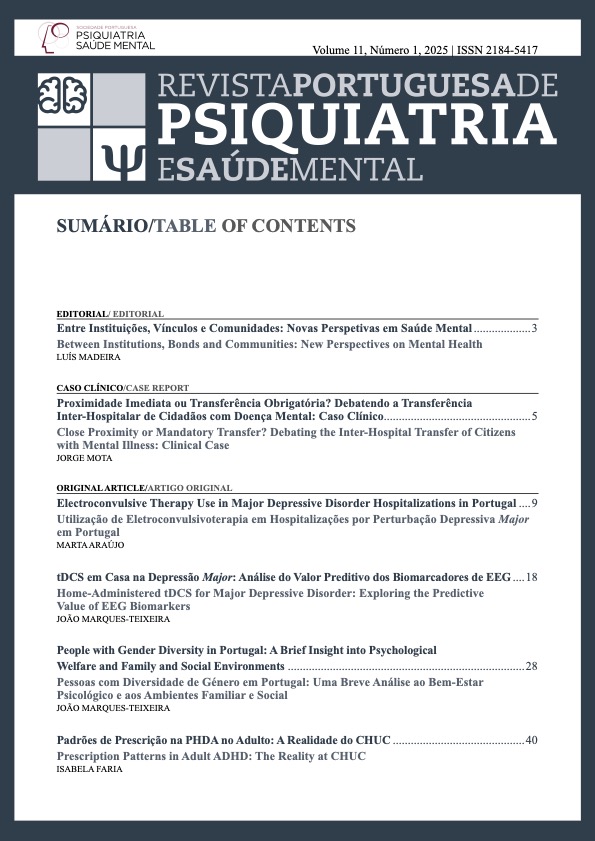Prescription Patterns in Adult ADHD: The Reality at CHUC
DOI:
https://doi.org/10.51338/rppsm.476Keywords:
Adult, Attention Deficit Disorder with Hyperactivity/drug therapy, Lisdexanfetamine, MethylphenidateAbstract
Introduction: Attention deficit hyperactivity disorder (ADHD) is one of the most common neuropsychiatric disorders, affecting around 2%‑4% of the adult population. The first‑line therapeutic intervention is psychostimulants such as methylphenidate and amphetamines. Second‑line therapy is used when stimulants are ineffective, intolerant, or contraindicated.Methods: Retrospective observational study of patients followed up at the Neurodevelopment Consultation at the Psychiatry Service of Coimbra Hospital and University Centre (CHUC), covering 2 years and 9 months of activity (January 2019 to September 2021) with a diagnosis of ADHD, to characterize the sample from a sociodemographic point of view and psychopharmacological prescription. Data was collected in September 2021 using SClínico. Data processing in Excel (version 16.46).
Results: The sample included 416 patients, 82 of whom were diagnosed with ADHD. The study found that 73% of the participants were male, with an average age of 21. Of the patients diagnosed with ADHD, 52.4% had the diagnosis isolated, while 47.6% had ADHD in comorbidity with another psychiatric condition. As for psychopharmacological prescriptions, 65.9% were medicated with methylphenidate, 46.3% with the maximum dose (54 mg once a day), and 7.4% with 36 or 40 mg once a day in both cases, with other doses prescribed less frequently.
Conclusion: Recent international studies report a prevalence of 90%‑92% of methylphenidate prescriptions in ADHD patients, with the reality of CHUC being lower (65.9%) than the international reality. This prevalence may be due to intolerance of adverse effects, low therapeutic adherence, or the presence of multiple comorbidities, which can lead to a decrease in prescriptions. Prescriptions should always be individualized and in accordance with the psychopathology presented. More studies are needed to assess the reality of Portuguese prescribing.
Downloads
References
Weibel S, Menard O, Ionita A, Boumendjel M, Cabelguen C, Kraemer C, et al. Practical considerations for the evaluation and management of Attention Deficit Hyperactivity Disorder (ADHD) in adults. L'encephale. 2020;46:30-40.
Faraone SV, Asherson P, Banaschewski T, Biederman J, Buitelaar JK, Ramos-Quiroga JA, et al. Attention-deficit/hyperactivity disorder. Nat Rev Dis Primers. 2015;1:15020.
Polanczyk GV, Willcutt EG, Salum GA, Kieling C, Rohde LA. ADHD prevalence estimates across three decades: an updated systematic review and meta-regression analysis. Int J Epidemiol. 2014;43:434-42.
American Psychiatric Association. Diagnostic and Statistical Manual of Mental Disorders. 5th ed. Chicago: American Psychiatric Publishing; 2013.
Xu G, Stratheran L, Liu B, Yang B, Bao W. Twenty-Year Trends in Diagnosed Attention-Deficit/Hyperactivity Disorder Among US Children and Adolescents, 1997-2016. JAMA Netw Open. 2018;1:e181471.
Paris J, Bhat V, Thombs B. Is Adult Attention-Deficit Hyperactivity Disorder Being Overdiagnosed? Can J Psychiatry. 2015;60:324-8.
Franke B, Faraone SV, Asherson P, Buitelaar J, Bau CH, Ramos-Quiroga JA, et al. The genetics of attention deficit/hyperactivity disorder in adults, a review. Mol Psychiatry. 2012;17:960-87.
Barkley RA, Murphy KR, Fischer M. ADHD in Adults: What the Science Says. New York: The Guilford Press; 2007.
Wilens TE, Isenberg BM, Kaminski TA, Lyons RM, Quintero J. Attention-Deficit/Hyperactivity Disorder and Transitional Aged Youth. Curr Psychiatry Rep. 2018;20:100.
Wilens TE, Spencer TJ. Understanding attention-deficit/hyperactivity disorder from childhood to adulthood. Postgrad Med. 2010;122:97-109.
Biederman J, Newcorn J, Sprich S. Comorbidity of attention deficit hyperactivity disorder with conduct, depressive, anxiety, and other disorders. Am J Psychiatry. 1991;148:564-77.
Cortese S, Faraone SV, Konofal E, Lecendreux M. Sleep in children with attention-deficit/hyperactivity disorder: meta-analysis of subjective and objective studies. J Am Acad Child Adolesc Psychiatry. 2009;48:894-908.
Antshel KM, Zhang-James Y, Faraone SV. The comorbidity of ADHD and autism spectrum disorder. Expert Rev Neurother. 2013;13:1117-28.
Wilens TE, Martelon M, Joshi G, Bateman C, Fried R, Petty C, et al. Does ADHD predict substance-use disorders? A 10-year follow-up study of young adults with ADHD. J Am Acad Child Adolesc Psychiatry. 2011;50:543-53.
Weibel S, Nicastro R, Prada P, Cole P, Rufenacht E, Pham E, et al. Screening for attention-deficit/hyperactivity disorder in borderline personality disorder. J Affect Disord. 2018;226:85-91.
Substantial increase in ADHD medication use in the US. PharmacoEcon Outcomes News. 2014;700:10.
Nigg JT, Tannock R, Rohde LA. What is to be the fate of ADHD subtypes? An introduction to the special section on research on the ADHD subtypes and implications for the DSM-V. J Clin Child Adolesc Psychol. 2010;39:723-5.
Wasserstein J. Diagnostic issues for adolescents and adults with ADHD. J Clin Psychol. 2005;61:535-47.
Chang Z, Lichtenstein P, D'Onofrio BM, Sjolander A, Larsson H. Serious transport accidents in adults with attention-deficit/ hyperactivity disorder and the effect of medication: a population based study. JAMA Psychiatry. 2014;71:319-25.
Lichtenstein P, Halldner L, Zetterqvist J, Sjolander A, Serlachius E, Fazel S, et al. Medication for attention deficit-hyperactivity disorder and criminality. N Engl J Med. 2012;367:2006-14.
Treuer T, Chan KL, Kim BN, Kunjithapatham G, Wynchank D, Semerci B, et al. Lost in transition: A review of the unmet need of patients with attention deficit/hyperactivity disorder transitioning to adulthood. Asia Pac Psychiatry. 2017;9.
NICE. NICE clinical guideline: attention deficit hyperactivity disorder: diagnosis and management, published 24 September 2008.
Kapur S, Paton C, Taylor DM. The Maudsley prescribing guidelines in psychiatry. Oxford: Wiley-Blackwell; 2015.
Connor DF. Stimulant and nonstimulant medications for childhood ADHD. In: Russel A, Barkley A, editors. Attention deficit hyperactivity disorder. A handbook for diagnosis and treatment. New York: The Guilford Press; 2015. p.3-50.
Faraone SV. The pharmacology of amphetamine and methylphenidate: Relevance to the neurobiology of attention-deficit/hyperactivity disorder and other psychiatric comorbidities. Neurosci Biobehav Rev. 2018;87:255-70.
Zuddas A, Banaschewski T, Coghill D, Stein, M. ADHD treatment: Psychostimulants. In: Banaschewski T, Coghill D, Zuddas A, editors. Oxford Textbook of Attention Deficit Hyperactivity Disorder. Oxford: Oxford University Press; 2018. p.379-92.
Johansson V, Sandin S, Chang Z, Taylor MJ, Lichtenstein P, D'Onofrio BM, et al. Medications for attention-deficit/hyperactivity disorder in individuals with or without coexisting autism spectrum disorder: analysis of data from the Swedish prescribed drug register. J Neurodevelop Disorders. 2020;12:1-12.
Raman SR, Man KK, Bahmanyar S, Berard A, Bilder S, Boukhris T, et al. Trends in attention-deficit hyperactivity disorder medication use: a retrospective observational study using population-based databases. Lancet Psychiatry. 2018;5:824-35.
Chai G, Governale L, McMahon AW, Trinidad JP, Staffa J, Murphy D. Trends of outpatient prescription drug utilization in US children, 2002-2010. Pediatrics. 2012;130:2331.
Ponizovsky AM, Marom E, Fitoussi I. Trends in attention deficit hyperactivity disorder drugs consumption, Israel, 2005-2012. Pharmacoepidemiol Drug Saf. 2014;23:534-8.
Hodgkins P, Sasane R, Meijer WM. Pharmacologic treatment of attention-deficit/hyperactivity disorder in children: incidence, prevalence, and treatment patterns in the Netherlands. Clin Ther. 2011;33:188-203.
Treceño C, Martin Arias LH, Sainz M, Salado I, Garcia Ortega P, Velasco V, et al. Trends in the consumption of attention deficit hyperactivity disorder medications in Castilla y Leon (Spain): changes in the consumption pattern following the introduction of extended release methylphenidate. Pharmacoepidemiol Drug Saf. 2012;21:435-41.
Dalsgaard S, Nielsen HS, Simonsen M. Five-fold increase in national prevalence rates of attention-deficit/hyperactivity disorder medications for children and adolescents with autism spectrum disorder, attention-deficit/hyperactivity disorder, and other psychiatric disorders: a Danish register-based study. J Child Adolesc Psychopharmacol. 2013;23:432-9.
Pauly V, Frauger E, Lepelley M, Mallaret M, Boucherie Q, Micallef J. Patterns and profiles of methylphenidate use both in children and adults. Br J Clin Pharmacol. 2018;84:1215-27.
Durand-Rivera A, Alatorre-Miguel E, Zambrano-Sanchez E, Reyes-Legorreta C. Methylphenidate Efficacy: Immediate versus Extended Release at Short Term in Mexican Children with ADHD Assessed by Conners Scale and EEG. Neurol Res Int. 2015;2015:207801.
Stuhec M, Lukic P, Locatelli I. Efficacy, acceptability, and tolerability of lisdexamfetamine, mixed amphetamine salts, methylphenidate, and modafinil in the treatment of attention-deficit hyperactivity disorder in adults: a systematic review and meta-analysis. Ann Pharmacother. 2019;53:121-33.
Cortese S, Adamo N, Del Giovane C, Mohr-Jensen C, Hayes AJ, Carucci S, et al. Comparative efficacy and tolerability of medications for attention-deficit hyperactivity disorder in children, adolescents, and adults: a systematic review and network meta-analysis. Lancet Psychiatry. 2018;5:727-38.
Chang Z, Lichtenstein P, Halldner L, D'Onofrio B, Serlachius E, Fazel S, et al. Stimulant ADHD medication and risk for substance abuse. J Child Psychol Psychiatry. 2014;55:878-85.








